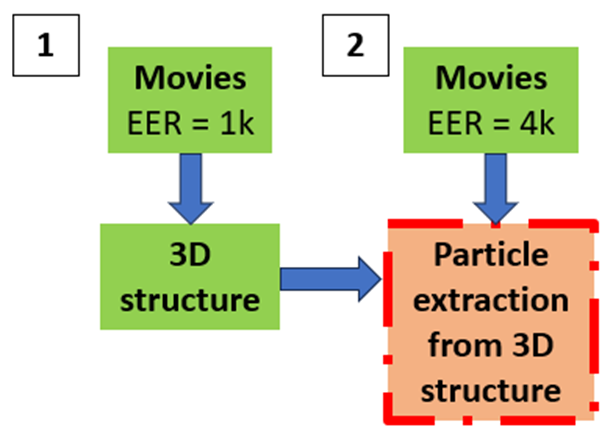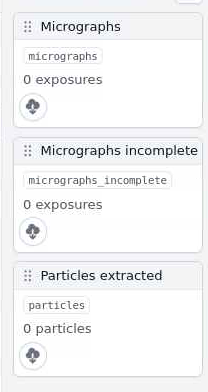Dear colleagues,
I have a result structure processed with initial EER upsampling factor 1.
Is there a way to get my result map with EER upsampling factor 4 without re-doing all the image analysis?
Thank you in advance.
Sincerely,
Dmitry
Dear colleagues,
I have a result structure processed with initial EER upsampling factor 1.
Is there a way to get my result map with EER upsampling factor 4 without re-doing all the image analysis?
Thank you in advance.
Sincerely,
Dmitry
I asked for the same sort of thing a while ago. ![]()
Although I think currently there is only 1 (4K), 2 (8K) and 3 (16K, although to my knowledge I’m the only person to have tried 16K sampling from EER and made the result public… breaking super res Nyquist isn’t easy (might be easier with Falcon 4i as they reported have ~80% better DQE at SR Nyquist… going by the TFS datasheets, anyway…)
Hello @rbs_sci,
Yes, indeed. I read your post some time ago.
So, is there no update on this topic yet?
Maybe Harris @hsnyder can prompt some solution?
The problem is that when shifting to 8k/16k/32k, all analysis needs to be redone, starting from particle picking.
Kind regards,
Dmitry
I remember reading somewhere that pick locations are stored as a fraction of the micrograph size rather than as absolute pixel locations. Is there anything stopping you from reassigning the existing particle stack to the newly upsampled motion-corrected micrographs and performing an extraction?
Cheers,
Yang
Dear Yang,
Thank you for your answer.
I would be very grateful if you shared your experience of the same particle extraction from the upsampled EER movies and from the same movies with no upsample factor applied.
In my case, this step doesn’t work.
In detail, I want to do the following.

So, as you can see, the Extracted Mics. (G) the protocol works well in case 1 seeing all micrographs and many particles
In case 2, where the input is the upsampled EER movies, although the total number of micrographs in the Extracted Mics. (G) is shown correctly, no particles were found from the same particles input as in the case 1.
And here is the result of this Extracted Mics. (G) protocol

So, I cannot re-extract the same particles obtained from EER- 1k movies and from EER 4k movies.
Please let me know if you have an idea how to do that.
Kind regards,
Dmitry
In case you haven’t already done so, you have to explicitly perform a Reassign Particles to Micrographs job prior to re-extraction in order to associate your particles with the newly-generated micrographs, and vice versa. Simply combining the two input sources for extraction won’t suffice.
Cheers,
Yang
thank you, Yang @leetleyang
Kind regards,
Dmitry
Just a query about this - what do you mean by “1K” and “4K”? Is there some other program which has more scaling than 1 (4K), 2 (8K) or 3 (16K)? I know RELION has an experimental 2K mode, but also wasn’t aware of a 32K mode.
Or do you mean Fourier cropping for 1K?
That said, any private code I’m obviously not privy to may well have those scalings… but 16K micrographs are hard enough to handle already that I don’t think anything could reasonably cope with 32K micrographs…?
Thanks. ![]()
I had assumed the op meant upsampling factor integers, of which cryoSPARC supports 1 (native), 2 (8K) and 4 (16K).
Cheers,
Yang
Dear @rbs_sci and Yang @leetleyang,
Thank you for your contributions to the discussion.
You clarified the matter.
I want to clarify that I am not referring to any specific type of upsampling, such as the 2 (8K) and 4 (16K) mentioned. My interest lies in understanding the procedure steps behind extracting the same particles from previously collected data without any scaling or upsampling (1-native) when working with upsampling in later movie analyses.
Kind regards,
Dmitry